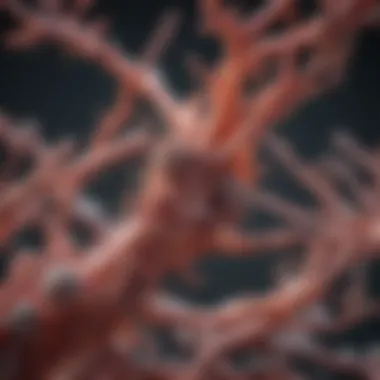Understanding Neurological Symptoms in Amyloidosis


Intro
Amyloidosis poses a substantial challenge to both diagnosis and treatment due to its multifaceted nature. Particularly, the neurological symptoms associated with this disorder garner significant attention. When amyloid proteins deposit in neural tissues, they can disrupt normal functioning, leading to symptoms that can vary widely among patients. Understanding these manifestations is essential for timely intervention and effective management.
This article aims to delineate the intricate relationship between amyloidosis and neurological impairment. It seeks not only to inform professionals in the medical field but also to engage those with a keen interest in understanding the nuances of this condition. This exploration will include the mechanisms at play, clinical manifestations, diagnostic methods, and therapeutic strategies, providing a comprehensive overview.
Research Overview
Methodological Approaches
Investigating the neurological manifestations of amyloidosis requires a blend of both clinical observation and advanced laboratory techniques. Researchers often employ a variety of methodologies:
- Case Studies: Individual case studies provide insights into distinct neurological symptoms and responses to treatment. These anecdotes are invaluable for understanding variability in presentations.
- Neuroimaging: Techniques such as MRI and CT scans help visualize amyloid deposits in the brain and assess their effect on neural integrity.
- Biomarker Analysis: Identifying specific biomarkers in cerebrospinal fluid can elucidate the extent of neurological involvement and guide treatment decisions.
These methods contribute to a greater understanding of how amyloidosis affects neural tissues, which is crucial for developing effective management protocols.
Significance and Implications
The implications of studying the neurological symptoms in amyloidosis are profound. An accurate understanding can lead to improved diagnostic accuracy and more effective treatments. For instance, identifying early signs of neurological involvement allows for timely intervention, which can slow disease progression. Furthermore, it highlights the need for interdisciplinary collaboration among neurologists, pathologists, and oncologists to optimize patient care.
Current Trends in Science
Innovative Techniques and Tools
Recent advancements in technology also inform the study of amyloidosis. New diagnostic tools are being created that enhance early detection and treatment efficacy. These include:
- PET Imaging: Positron Emission Tomography is being developed to detect amyloid deposits non-invasively.
- Machine Learning Algorithms: These are being refined to analyze neurological symptoms and stratify patients more effectively based on their clinical profiles.
These innovations hold promise for better understanding and managing the neurological complexities associated with amyloidosis.
Interdisciplinary Connections
The study of neurological symptoms in amyloidosis is increasingly recognized as an interdisciplinary endeavor. Collaboration between different specializations enhances the quality of research and clinical practice. Neurology, oncology, and even genetics play a role in captivating the broader picture. This comprehensive approach fosters a richer understanding
"Understanding the intersection of different disciplines is critical in tackling complex conditions like amyloidosis."
In summary, the study of neurological symptoms within the scope of amyloidosis is paramount for advancing both clinical practice and research. Recognizing the diversity of symptoms and their implications aids in forming a holistic perspective that benefits patient outcomes.
Intro to Amyloidosis
Amyloidosis is a complex condition that affects multiple systems in the body, predominantly causing serious organ damage. It arises from the accumulation of abnormal proteins known as amyloids. Understanding amyloidosis is crucial as it provides insight into the various manifestations of the disease, which includes significant neurological involvement. Neurological symptoms such as peripheral neuropathy and cognitive impairments challenge both diagnosis and treatment, significantly impacting the quality of life for affected individuals. By examining amyloidosis in detail, we can better grasp the state of the individual suffering from this disorder, leading to improved management and therapeutic strategies.
Defining Amyloidosis
Amyloidosis can be defined as a group of diseases that are characterized by the deposition of amyloid protein in tissues and organs. These proteins are misfolded and accumulate, causing damage to the organ system involved. There are several subtypes of amyloidosis, each with distinct etiologies, clinical features, and potential treatments. A clear definition helps in acknowledging the heterogeneity of the disease and prepares the groundwork for discussing the specific types and their implications.
Types of Amyloidosis
Each type of amyloidosis has unique characteristics that shape both its progression and treatment options. Understanding these types is essential for accurate diagnosis and management.
- Primary Amyloidosis (AL): This type is associated with plasma cell disorders, in which monoclonal immunoglobulin light chains are produced. It is significant because it directly relates to hematologic conditions like multiple myeloma. The key characteristic of AL amyloidosis is that it is often systemic, affecting multiple organs, including the heart and kidneys. Its early detection and management are crucial to avoid severe organ damage. The unique feature of Primary Amyloidosis lies in its unpredictable progression, which can lead to rapid deterioration in some patients, while others may experience a more gradual decline.
- Secondary Amyloidosis (AA): This type develops in the backdrop of chronic inflammatory conditions such as rheumatoid arthritis or inflammatory bowel disease. The key characteristic of AA amyloidosis is the production of serum amyloid A protein in response to inflammation. It is beneficial in this article because it links chronic diseases with amyloid deposition, highlighting preventive strategies in the management of these underlying conditions. Secondary amyloidosis may have unique advantages, such as being somewhat reversible if the underlying condition is treated effectively.
- Hereditary Amyloidosis (ATTR): This form arises due to genetic mutations leading to the production of abnormal transthyretin protein, typically affecting the nerves and heart. A key characteristic is its hereditary nature, which means family history plays a critical role in risk assessment. The unique feature of Hereditary Amyloidosis is that it often presents with neurological symptoms earlier than other forms, alerting clinicians to its presence. This aspect makes early detection and genetic counseling vital. However, treatment options may be limited, making prognosis more variable compared to the other types.
Understanding these types of amyloidosis provides a framework for healthcare professionals to recognize, diagnose, and manage the condition effectively. This knowledge ultimately enhances strategies for addressing the diverse neurological symptoms associated with amyloidosis.
Pathophysiology of Amyloidosis
The pathophysiology of amyloidosis is crucial for understanding how this condition leads to neurological symptoms. Amyloidosis entails the abnormal deposition of amyloid proteins, which can affect various organs and tissues. In particular, the nervous system is susceptible to these changes. Understanding the mechanisms at play offers insights into potential diagnostics and therapeutic avenues. When amyloid fibrils deposit in the nervous system, they disrupt normal cellular function, leading to a spectrum of neurological manifestations.
Formation of Amyloid Fibrils
Amyloid fibrils are misfolded proteins that aggregate in a specific way. These proteins can arise from several sources, such as immunoglobulins in primary amyloidosis or serum amyloid A in secondary amyloidosis. The process begins with protein misfolding, which is often influenced by genetic factors, environmental stressors, or underlying diseases.
Once misfolding occurs, the proteins aggregate into soluble oligomers before forming insoluble fibrils. These fibrils are resistant to degradation and can accumulate in tissues. This accumulation can take years before clinical symptoms arise, which is why early detection is challenging. The fibrils themselves not only occupy space in tissue but also interact with cellular structures, which leads to dysfunction.
Misfolded proteins can disrupt normal cell signaling, contribute to inflammation, and cause cellular death.
Tissue Infiltration and Organ Dysfunction


As amyloid fibrils infiltrate tissues, they exhibit a widespread impact on organ function. In the nervous system, this infiltration can damage neurons and glial cells. When amyloid deposits accumulate, they can lead to peripheral neuropathy or even autonomic neuropathies. These conditions manifest through various neurological symptoms, including numbness, tingling, and weakness.
The implications extend beyond the nervous system; lesions can also develop in other organs like the heart, kidneys, and liver. This multi-organ involvement can complicate diagnosis and management, as symptoms might initially be mistaken for other conditions. Understanding tissue infiltration highlights the necessity for a comprehensive diagnostic approach to amyloidosis, especially since neurological symptoms can be subtle and easily overlooked.
In summary, the pathophysiology of amyloidosis involves both the formation of amyloid fibrils and their resultant infiltration into various tissues. This understanding is fundamental to appreciating the complexity of neurological symptoms that arise in amyloidosis.
Neurological Involvement in Amyloidosis
Neurological involvement in amyloidosis is a critical aspect of this complex condition. It underlines the multifaceted impact that amyloid protein deposition has on the nervous system. Understanding this connection is key as it directly influences patient quality of life and overall prognosis.
The nervous system is especially vulnerable due to its intricate architecture and energy demands. Amyloid deposits can disrupt normal function and lead to significant neurological symptoms. By recognizing the neurological aspects early, healthcare providers can implement timely interventions.
Detailed exploration of neurological symptoms can aid in crafting effective management strategies that target both the underlying amyloidosis and its neurological manifestations.
Mechanisms of Neurological Damage
The mechanisms underpinning neurological damage in amyloidosis primarily involve direct damage to neuronal structures and indirect effects through interference with vascular supply.
Amyloid fibrils can accumulate in the peripheral nerves, leading to demyelination. This demyelination slows down nerve impulse transmission. In addition, amyloid deposits in blood vessels can compromise their integrity, resulting in reduced blood flow to critical areas of the brain and nerves. This combination of effects contributes significantly to the clinical neurological symptoms observed in patients.
Types of Neurological Symptoms
Neurological symptoms in amyloidosis can manifest in several ways. The most prominent types include:
Peripheral Neuropathy
Peripheral neuropathy is a common and debilitating symptom associated with amyloidosis. It involves damage to the peripheral nervous system, which can lead to pain, numbness, and tingling sensations in the arms and legs. The key characteristic of peripheral neuropathy in this context is its often gradual onset, making it a noticeable yet insidious problem.
Addressing peripheral neuropathy is essential for managing overall symptoms in amyloidosis patients, as it can severely limit daily functioning. Unique features of peripheral neuropathy include its variability in presentation among individuals and responsiveness to certain medications designed to alleviate symptoms.
Autonomic Neuropathy
Autonomic neuropathy represents another significant area of concern in amyloidosis. This type affects the autonomic nervous system, which regulates involuntary bodily functions. Symptoms can range from orthostatic hypotension to gastrointestinal disturbances. A key characteristic is the breadth of systems it influences, often affecting heart rate, blood pressure, and digestion.
Autonomic neuropathy is important to highlight because it encompasses a wide range of symptoms that can be misattributed to other conditions. Its unique feature, the interconnectedness with various bodily functions, presents both diagnostic challenges and therapeutic opportunities.
Cognitive Impairments
Cognitive impairments can also arise as a result of amyloidosis. Patients may experience issues with memory, concentration, and overall cognitive function. This aspect draws attention due to its profound effect on patients' daily lives.
The key characteristic of cognitive impairments in amyloidosis is their potential to develop insidiously, paralleling the physical symptoms. Unique features include the variability depending on the individual's overall health and the accumulation of amyloid within the brain, which can complicate the clinical picture.
Clinical Presentation of Neurological Symptoms
The clinical presentation of neurological symptoms in amyloidosis is important for several reasons. It offers insight into how amyloidosis affects the neurological system, which can vary widely among individuals. Understanding these symptoms aids in early diagnosis and better management, ultimately influencing patient outcomes. Neurological complications significantly impact quality of life, making recognition of symptoms crucial for timely intervention.
Common Neurological Symptoms
Numbness and Tingling
Numbness and tingling are common symptoms in individuals with amyloidosis. These sensations often start in the fingers and toes, signaling peripheral neuropathy. The key characteristic is their unpredictable nature, which can worsen over time or lead to a constant sense of discomfort.
Numbness and tingling are beneficial for this article as they often serve as early indicators of neurological involvement in amyloidosis. Recognizing these sensations can lead to quicker diagnosis and allow for earlier treatment strategies. The unique feature of this symptom is its potential to interfere with daily activities. Patients might find it challenging to grip objects or may experience frequent drops, leading to frustration.
Muscle Weakness
Muscle weakness is another significant neurological symptom observed in amyloidosis. It typically results from nerve damage and can affect both mobility and manual dexterity. The key aspect of muscle weakness is its gradual onset, which can make it difficult for patients to recognize initially.
Muscle weakness is popular in this article because it highlights the broader implications of amyloidosis beyond sensory symptoms; it affects muscle function and overall physical abilities. The unique feature worth noting is its variability—some patients may have mild weakness, while others face severe limitations. This variability presents both advantages and disadvantages, as it can sometimes lead to misdiagnosis or delayed treatment.
Pain
Pain associated with neurological symptoms in amyloidosis often manifests as neuropathic pain, which may include burning or shooting sensations. The key characteristic of this symptom is its relationship to nerve damage, making it distinct from typical musculoskeletal pain.
Pain is a crucial aspect for this article, as it directly affects the patient's quality of life and necessitates effective management strategies. The unique feature of pain in this context is its complexity; it may not respond well to standard pain relief medications and can require specific therapeutic approaches. This can complicate treatment plans and necessitate a multidisciplinary approach involving pain management specialists.
Recognizing Early Signs
Recognizing early signs of neurological symptoms can make a substantial difference in patient management. Awareness of subtle changes, such as the onset of numbness, tingling, or mild muscle weakness, can prompt timely medical evaluations. These early signs often serve as key indicators for healthcare professionals, guiding them towards a quicker diagnosis of amyloidosis. Early recognition not only improves prognosis but also empowers patients to seek help before symptoms become overwhelming.


Diagnostic Approaches
The evaluation of neurological symptoms in patients with amyloidosis is a crucial step in the management of the condition. Diagnostic approaches not only confirm the presence of neurological involvement but also delineate the type and extent of damage caused by amyloid deposits. This section examines the core strategies employed in clinical practice to identify and assess these symptoms, thus enhancing the understanding of the disease's impact on the nervous system.
Clinical Evaluation
Clinical evaluation serves as the foundational component for diagnosis. This process usually begins with a detailed patient history and a comprehensive neurological examination. The healthcare provider looks for specific neurological signs such as muscle weakness, numbness, and cognitive changes. During this initial assessment, patients may report symptoms that can be attributed to peripheral or autonomic neuropathy, which are common in amyloidosis.
A standardised checklist may be employed to ensure that no symptoms go unnoticed. It can include:
- Assessment of Sensory Function: Evaluating responses to light touch, pain, and temperature is fundamental.
- Motor Function Review: Checking muscle strength and reflexes helps detect motor neuron involvement.
- Assessment of Cognitive Function: Simple tests that assess memory and orientation may point to cognitive impairments associated with amyloid deposition in the central nervous system.
Furthermore, clinical evaluation considers comorbid conditions that might mimic or complicate the clinical picture, thus requiring careful interpretation of findings.
Neurophysiological Testing
Neurophysiological testing plays a vital role in diagnosing and characterizing neurological involvement in amyloidosis. This includes a variety of tests that evaluate the function of the nervous system and helps determine the type of neuropathy present. Two main tests typically used are nerve conduction studies and electromyography (EMG).
- Nerve Conduction Studies (NCS): This test measures how quickly electrical signals move through the peripheral nerves. In patients with amyloidosis, slowed conduction velocities or reduced amplitude of responses may indicate peripheral nerve damage.
- Electromyography (EMG): This test assesses the electrical activity of muscles. It helps identify any muscle weakness caused by nerve damage. Abnormal EMG findings can assist in differentiating between neuropathies affecting nerves versus muscular conditions.
These evaluations are crucial as they provide insights into the extent of neurological involvement, guiding future diagnostic and therapeutic decisions.
Biopsy and Amyloid Staining
A definitive diagnosis of amyloidosis often requires histological examination. Biopsy plays a central role in this process, particularly in demonstrating amyloid deposits. There are various types of biopsies that can be performed:
- Subcutaneous Fat Biopsy: This is the most common and less invasive method. It involves removing a small sample of fat tissue where amyloid may deposit.
- Bone Marrow Biopsy: This may be performed to assess for plasma cell dyscrasia—a feature in AL amyloidosis.
- Organ Biopsies: In some cases, biopsies from affected organs such as the kidney or liver may be necessary.
Once the tissue is obtained, specific staining techniques are employed to identify amyloid deposits. Congo red staining is the classic method, which shows a characteristic apple-green birefringence under polarized light. The presence of amyloid deposits confirms the diagnosis of amyloidosis and helps characterize the type.
"Biopsy remains the gold standard for diagnosing amyloidosis, providing vital information that influences management decisions."
In summary, diagnostic approaches for neurological symptoms in amyloidosis combine clinical evaluation, neurophysiological testing, and histological confirmation. Each method contributes to a comprehensive understanding of the disease and is essential for guiding effective management strategies.
Management of Neurological Symptoms
Managing the neurological symptoms associated with amyloidosis is a critical aspect of patient care. These symptoms can significantly impact patients' quality of life, necessitating a comprehensive approach to alleviate their effects. Effective management can enhance functional abilities, improve well-being, and possibly slow disease progression. This section will delve into various management strategies, emphasizing both pharmaceutical and supportive care options.
Pharmacological Interventions
Medications are often the first line in addressing neurological symptoms in amyloidosis patients. They can vary widely, depending on the specific symptoms experienced and the patient's overall health.
Chemotherapy
Chemotherapy plays a significant role in treating primary amyloidosis, particularly in cases where light chains are produced in excess. The main characteristic of chemotherapy in this context is its ability to target malignant plasma cells, reducing the production of amyloid proteins. This approach is commonly chosen because it can lead to a reduction in amyloid deposits, thus potentially mitigating associated neurological symptoms.
However, chemotherapy is not without its drawbacks, including potential side effects like nausea, fatigue, and immunosuppression. These may complicate the overall treatment experience for patients, necessitating careful monitoring.
Immunotherapy
Immunotherapy is an emerging treatment option for amyloidosis that focuses on enhancing the body's immune response against the underlying causes of protein misfolding. Its key characteristic is its ability to selectively target the amyloidogenic processes while sparing healthy tissues. This strategy is becoming popular as it may offer a more personalized approach, specifically suited to an individual patient's profile.
The unique feature of immunotherapy lies in its ability to provide long-term benefits with potentially fewer side effects than traditional chemotherapy. Still, it may not be suitable for all patients, particularly in advanced stages of the disease.
Symptom Relief Medications
Symptom relief medications, such as analgesics and nerve pain treatments, are essential in the management strategy for amyloidosis-related neurological symptoms. These medications can provide immediate relief for common symptoms like pain, numbness, and tingling, which are frequently debilitating for patients. Their key characteristic is their accessibility and the speed at which they can improve quality of life.
However, the risk of dependency or side effects can be a concern. Balancing symptom relief with these potential risks is necessary for effective management.
Supportive Care and Rehabilitation
In addition to pharmacological interventions, supportive care and rehabilitation are vital components of managing neurological symptoms. These therapies aim to help patients regain independence and maintain functionality.
Physical Therapy
Physical therapy focuses on improving movement and reducing pain through specific exercises. Its primary benefit is enhancing mobility, strength, and flexibility. This can be particularly beneficial for patients experiencing muscle weakness or coordination issues caused by amyloidosis.


One unique feature of physical therapy is the customization of treatment plans to meet individual patient needs. However, progress can be slow, and patients may require sustained motivation to engage in regular sessions.
Occupational Therapy
Occupational therapy aims to restore patients' daily living skills, making it essential as patients cope with cognitive or physical impairments. This therapy is beneficial as it helps patients adapt their environment and activities to their needs, promoting independence.
One notable characteristic of occupational therapy is its focus on individual goals, which can enhance patient motivation. A potential disadvantage may include limited access to therapists, particularly in rural areas.
Neurological Rehabilitation
Neurological rehabilitation is a comprehensive program tailored for those who have experienced significant neurological deficits. This therapy focuses on restoring functions through multimodal approaches, including exercises, adaptive techniques, and psycho-social support.
The unique feature of neurological rehabilitation is its holistic view of recovery, addressing both physical and emotional aspects of health. However, this approach often requires a multidisciplinary team, which may not always be available to every patient.
Effective management of neurological symptoms in amyloidosis is a multi-faceted approach that combines pharmacological interventions and supportive care strategies. Each component plays a vital role in a patient's overall health journey, aiming to improve their quality of life.
Prognosis of Neurological Symptoms in Amyloidosis
The prognosis of neurological symptoms in amyloidosis plays a critical role in understanding patient outcomes and guiding treatment decisions. Given that amyloidosis can affect various systems in the body, including the nervous system, comprehending the potential long-term effects is significant. The neurological manifestations can severely impact quality of life, thus making the assessment of prognosis essential for clinical practice and patient management.
A thorough grasp of prognosis not only aids in setting realistic expectations for patients but also influences the choice of therapeutic interventions. As the dynamics of amyloidosis unfold, certain patterns emerge concerning symptom progression and response to treatment. Ultimately, prognosis shapes conversations between clinicians and patients, fostering informed decision-making.
Long-Term Outcomes
Long-term outcomes for patients with neurological symptoms related to amyloidosis vary widely and depend on multiple factors. These include the type of amyloidosis, the extent of neurological involvement, and the effectiveness of interventions. While some patients may experience stabilization or gradual improvement of symptoms with appropriate treatment, others may face persistent challenges or progressive neurological deterioration.
Research indicates that individuals with hereditary amyloidosis (ATTR) often have a better overall prognosis compared to those with primary amyloidosis (AL). The clinical scenario is complex, but it can often lead to substantial disability or even premature mortality. Therefore, it is crucial to monitor patients closely and adjust management strategies accordingly.
"Understanding the prognosis allows both patients and caregivers to better navigate the complexities of living with amyloidosis."
Factors Influencing Prognosis
Several factors play a pivotal role in influencing the prognosis of neurological complications in amyloidosis. Among these, the following are particularly noteworthy:
- Type of Amyloidosis: Different types exhibit unique clinical patterns and relate to varying outcomes.
- Duration of Symptoms: The longer the neurological symptoms have been present before diagnosis, often the poorer the prognosis.
- Response to Treatment: How well a patient responds to chemotherapy, immunotherapy, or supportive care significantly impacts long-term outcomes.
- Extent of Organ Involvement: Patients with multiple organ systems affected generally have a more serious prognosis than those with isolated neurological symptoms.
These factors underscore the complexity inherent in prognosis within amyloidosis, emphasizing the need for personalized approaches in treatment and care.
Research Advances and Future Directions
The exploration of neurological symptoms in amyloidosis is an evolving field, reflecting the intricate relationship between amyloid deposits and the nervous system. Understanding these advancements is crucial, as it shapes both current clinical practices and future therapeutic strategies. As researchers delve deeper into the mechanisms at play, they uncover insights that could improve diagnosis and enhance patient management.
Recent advancements in research are shedding light on biomarkers and imaging techniques that may assist in the early detection of neurological involvement. This is pivotal because early intervention can significantly alter disease outcomes. Moreover, studies are increasingly focusing on the pathogenic mechanisms resulting from amyloid protein accumulation, offering potential targets for new treatments.
"Progress in amyloidosis research directly correlates with improved patient outcomes, particularly in managing neurological symptoms."
New therapeutic options emerge continuously, as researchers explore how existing medications can be repurposed. Understanding the specific pathways of amyloidosis can lead to more targeted therapies that help mitigate neurological impacts. Furthermore, interdisciplinary approaches are gaining traction, integrating insights from neurology, hematology, and pathology to form a comprehensive strategy in managing symptoms.
Current Research Trends
Currently, the landscape of amyloidosis research indicates a strong push toward precision medicine. This involves tailoring treatments based on the specific characteristics and symptoms of the disease in each patient. Some notable trends include:
- Development of Clinical Trials: Investigations are underway to evaluate new drugs that could target amyloid formation more effectively. The focus is on therapies that not only halt the progression of the disease but also reverse neurological damage.
- Genetic Studies: Examining the genetic factors associated with amyloidosis helps identify individuals at risk and informs preventive strategies. This is particularly true in hereditary forms of the disease.
- Longitudinal Studies: Tracking patients over extended periods provides valuable data on the natural history of neurological symptoms, which can help refine treatment approaches.
Potential Therapeutic Approaches
As research evolves, several potential therapeutic approaches are emerging to address neurological symptoms in amyloidosis more effectively:
- Monoclonal Antibodies: These are designed to target and remove amyloid proteins from tissues, with some studies showing promising results in improving symptoms and halting disease progression.
- Gene Therapy: Innovative techniques aim to correct genetic defects that lead to abnormal amyloid protein production. While still in early stages, this approach holds notable potential.
- Neuroprotective Agents: Compounds that can safeguard neuronal function from amyloid toxicity are being explored. This includes medications that can enhance neuronal resilience and improve cognitive function.
In summary, ongoing research in neurological symptoms related to amyloidosis is paving the way for improved diagnostic and therapeutic strategies. As these advances unfold, they may provide the critical tools needed to enhance the quality of life for patients suffering from this complex disease.
Finale
Summary of Key Points
- Amyloidosis is a complex disease affecting multiple body organs, with neurological symptoms being particularly impactful.
- Types of neurological symptoms include peripheral neuropathy, autonomic neuropathy, and cognitive impairments, each requiring targeted management strategies.
- Diagnostic methods, such as neurophysiological testing and biopsy, are essential for accurate identification of neurological involvement in amyloidosis.
- Management of neurological symptoms often includes pharmacological interventions, supportive care, and rehabilitation strategies to improve patient outcomes.
- Research is ongoing, with new therapeutic approaches being explored that may enhance the quality of life for people suffering from these symptoms.
Overall, a nuanced approach to understanding the symptoms can improve clinical efficacy, support patient education, and enhance overall care strategies.
Implications for Clinical Practice
The findings about neurological symptoms in amyloidosis underscore essential considerations for clinical practice. Health professionals should be vigilant in monitoring for these symptoms among patients diagnosed with amyloidosis, as early detection can lead to better management outcomes.
- Multidisciplinary collaboration is vital, as neurological symptoms may need the involvement of neurologists, hematologists, and rehabilitation therapists.
- Education on symptom recognition can empower patients and caregivers, enhancing their engagement in the management process.
- Individualized treatment plans are important, taking into account the type of neurological involvement, patient preferences, and existing comorbidities.
- Continual professional development in understanding amyloidosis and its neurological connections will equip healthcare providers with the necessary knowledge to implement effective treatment strategies.



